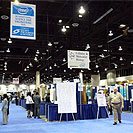An Intel ISEF Project
06/02/2009

A high school science project (Bergen County Academies, Hackensack, NJ), conducted using the centrifuge facilities at Columbia University, won the finalist award at the North Jersey Regional Science Fair in March, and went on to represent North Jersey at the Intel International Science and Engineering Fair (ISEF) held in Reno, Nevada in mid-May. ISEF, the largest event of such kind, was attended by finalists from all 50 states plus 56 countries. The project involved the modeling of rainfall-induced landslides, jointly supervised by Hoe Ling (Professor of GeoEngineering) and Liming Li (Centrifuge Manager). This project will also be presented in the Student Outreach Session during the coming NSF Engineering Research and Innovation Conference to be held in Honolulu, Hawaii in late June.
Involvement of research at the high school level is becoming very popular and important. Some students do it out of interest, while others consider it an important experience to gain admission into the top Ivy League universities. As a supervisor, the key issue is how to help these students to acquire cutting-edge knowledge in science and engineering based on their rather limited skills in basic science and mathematics. By providing guidance to students on their science and engineering projects at their early age, mentors can attract some of the best students to the field. This is especially true for traditional engineering compared to other fields which may have abundant research funding.
Research institutions such as Columbia University have been criticized as being too much focused on funded projects, and thus we tend to neglect the requests of undergraduate research. Too often, their requests are declined in the premier laboratories. Because many students started gaining research experience during their high school years, they cannot afford to stop when they enter college. We are yet to be able to respond positively toward this demand because of a shortage in staff.
[by Hoe Ling]
P.S. In 2010 and 2011, additional studies were conducted on the simulation of a 27-m slope that failed in Japan during typhoon Nabi.The project was awarded semi-finalist in the Siemens Competition, and also won the first place in Northern Jersey Junior Science andHumanities Symposium (JSHS) and as finalist to the 49th National JSHS. (6/13/2011)